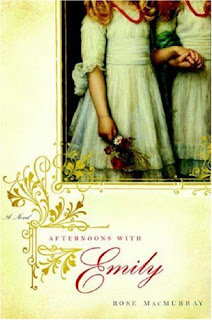Afternoons With Emily
Drawing on letters, poems, and everything that is known about Dickinson's life, Afternoons With Emily is a vivid portrait of America's most famous poet, a coming-of age story that spans the Civil War, and a tale of two brilliant women who each chose to break with convention and live life on their own terms.
Review: This novel is about a young girl, originally called Arethusa who becomes friends with the reclusive Emily Dickinson. Arethusa was born to a consumptive mother and basically lived on the attic floor like an orphan until her mother's death when her father took her to Barbados. In Barbados she was reborn, changed her name to Miranda, and traveled to her new home in Amherst a changed, and very bright girl. Because of her strong will and high performance at school, Emily Dickinson, who was twice her age, invited her to call on her once a week (thus the title of the book). Emily fades in and out of importance throughout the novel as Miranda falls in love, loses family members, begins a young education initiative, and finds her purpose in life.
I liked Miranda as a character and narrative. She had a dignified voice and worked hard to achieve her purpose in life and do what was morally right. However, ironically, the reason I first picked this book up (references to Emily Dickinson) was my least favorite aspect of the novel. Emily was delusional, aggravating, seemed very mentally disturbed, and was very untrustworthy throughout the novel. Miranda constantly makes reference to how her poetry is her only saving grace and hopefully they will be worth what a horrible person Emily is. Additionally, Emily is most definitely a side character, and in fact, many other people figure more prominently in Miranda's life at different points in the novel, making the title of the book a bit of a misnomer.
I enjoyed the time period of this book and the scattering of Emily's poetry throughout. Additionally, I was moved by the author's story - she worked on this novel for several years but died before it could be published. An enjoyable read despite Emily Dickinson's less than enjoyable personality as a character.
Stars: 3



Comments
Post a Comment